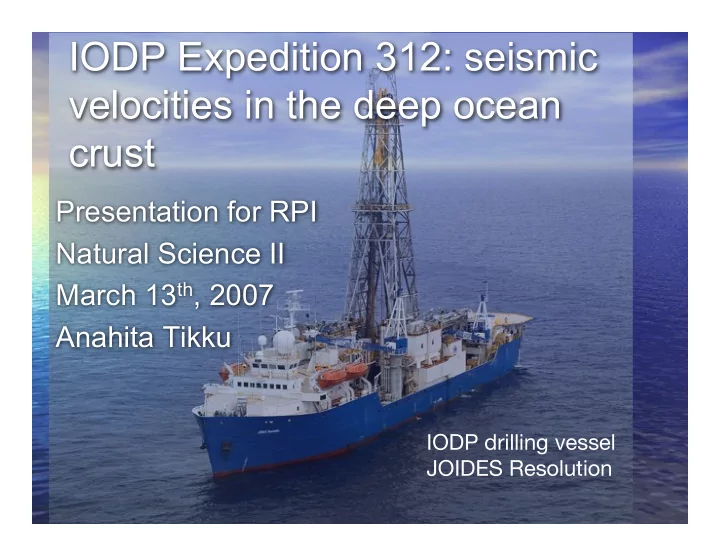

IODP Expedition 312: seismic velocities in the deep ocean crust Presentation for RPI Natural Science II March 13 th , 2007 Anahita Tikku IODP drilling vessel JOIDES Resolution
What is IODP? • The Integrated Ocean Drilling Program (IODP) is an international marine research drilling program dedicated to advancing scientific understanding of the Earth by monitoring and sampling subseafloor environments. • IODP science focuses on four principal themes: the deep biosphere and the subseafloor ocean; environmental change; Earth processes and effects; and solid earth cycles and geodynamics. (for more info see: http://www.iodp.org)
How does ocean drilling work?
How does ocean drilling work? “Tripping pipe” at the surface. Re-entering drill hole.
Drill cores: what do you get?
Expedition 312: drilling objectives • The goal of the Superfast Spreading Rate Crust mission (spanning ODP Leg 206, and IODP Expeditions 309 and 312) was to core through the entire sequence of extrusive rocks, the underlying sheeted dike complex, and into the upper gabbros at a site in the eastern Pacific Ocean (Site 1256D). • Though gabbros constitute the majority of the oceanic crust, they have not been sampled in situ previously.
What are gabbros? • Gabbros are dark, coarse-grained, intrusive igneous rock chemically equivalent to basalt. It is a plutonic rock, formed when molten magma is trapped beneath the Earth's surface and cools into a crystalline mass.
Scientific goals of expedition: • Provide the first sampling of a complete section of oceanic crust to the gabbros. • Confirm whether ocean crust formed at a superfast spreading rate conforms to classic ophiolite stratigraphy. (Ophiolites are slivers of oceanic crust that have been obducted - overthrust and accreted to the continental crust.) • Confirm the nature of high-level axial magma chambers. • Define the relationship between magma chambers and their overlying lavas and the interactions between magmatic, hydrothermal, and tectonic processes. • Provide in situ calibration of seismic velocity and magnetic measurements made from surface ships so that these regional-scale geophysical measurements can be related to geology.
Mid-ocean ridges: where new ocean crust is created Artist's cross section illustrating the main types of plate boundaries. From This Dynamic Planet -- produced jointly by the U.S. Geological Survey, the Smithsonian Institution, and the U.S. Naval Research Laboratory.)
Textbook oceanic crustal structure Figure from: Kennett (1982)
Obduction & formation of ophiolites
Ocean drilling site distribution
Deep ocean drilling sites are few
Site 1256D: location of Exp 312
P-wave seismic velocities in rocks (generally between 4-7 km s -1 )
Seismic velocity is a function of: • Porosity (more porous - slower velocity) • Density (more dense - higher velocity) • Microcracks (more cracking - lower velocity) • Mineralogy (more complicated) • ? Solid, dense rocks transmit signals faster and with less dispersion.
Seismic velocity as a function of density: experimental results Figure from Carlson & Herrick (1990)
Wireline Tool Strings IODP Logging Services IODP Logging Services
Dipole Shear Sonic Imager (DSI) The DSI uses a combination of monopole and dipole transducers to make measurements of sonic wave propagation in a wide variety of lithologies. - The monopole transducer excites compressional and shear waves at high frequencies. - A low-frequency source enables Stoneley waveforms to be acquired. - These “guided” waves are associated with the solid-fluid boundary at the borehole wall and their amplitude decays exponentially away from the boundary in both the fluid and the formation. USIO Science Services - LDEO USIO Science Services - LDEO
Seismic layers in oceanic crust Downhole Logging data Seismic layer 2 constitutes the upper crust and is characterized by a rapid increase in seismic velocity with depth, and a thicker lower crust Seismic layer 3 constitutes the thicker lower crust and is distinguished from layer 2 by both a higher P-wave velocity & a much smaller vertical velocity gradient.
Seismic velocities from cubes at 1256D
Seismic velocities downhole at Site 1256D
Seismic velocity anomaly at sheeted dike-gabbro boundary?
Experimental setup for high pressure seismic velocity measurements
Seismic velocity as a function of pressure microcracks
New downhole seismic velocity profile Sonic log downhole velocities Shipboard ambient P velocities 1000 bar velocities
Fun at sea!
Recommend
More recommend